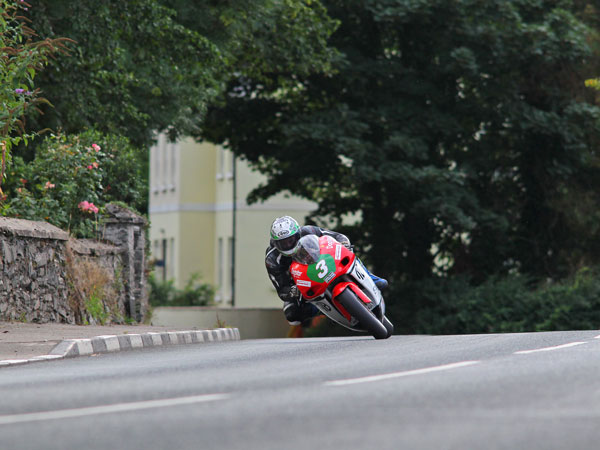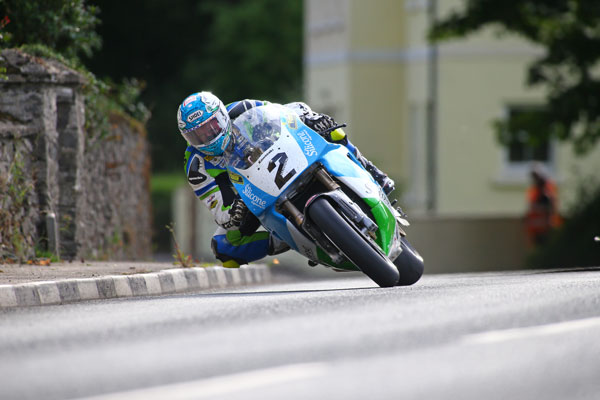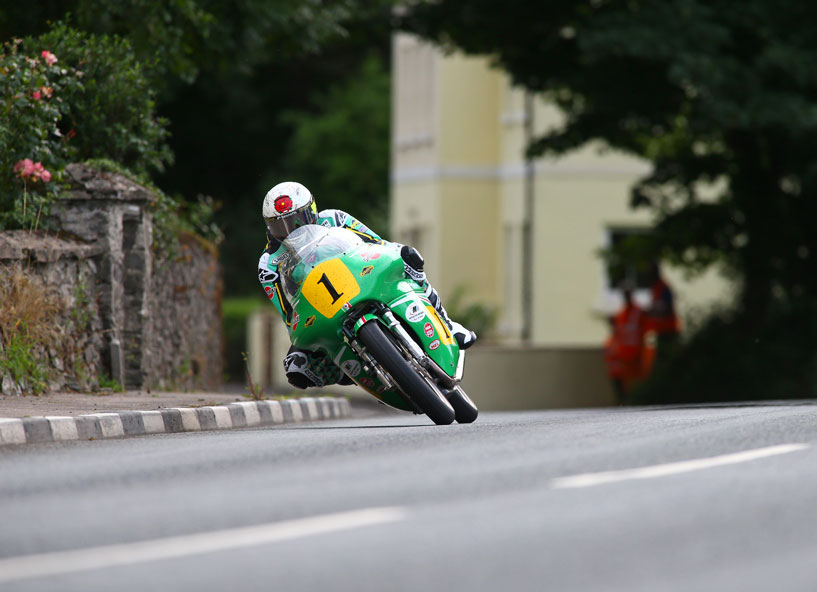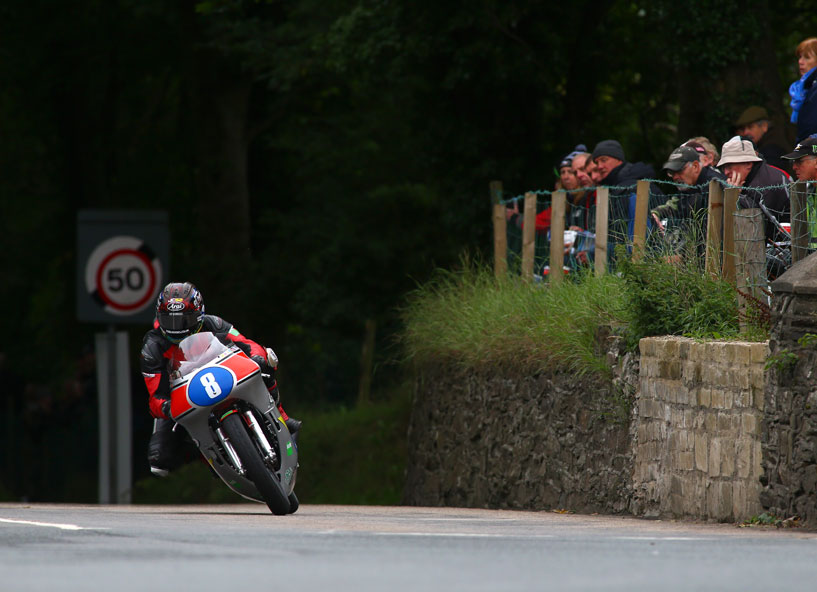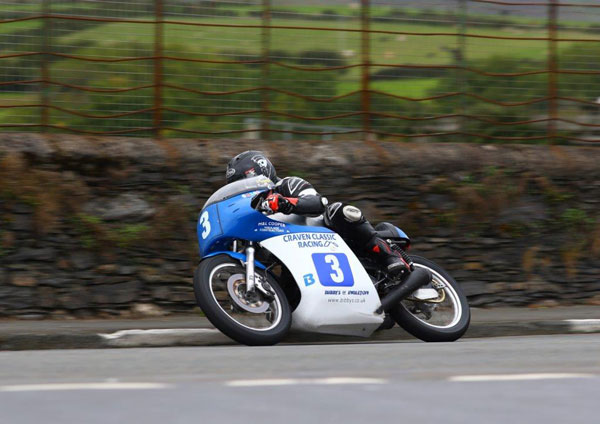THE MOUNTAIN: NOT FOR WIMPS!
With a course that has remained largely untouched since 1911, the 37 plus miles of public roads captures the imagination like no other motorcycling venue can. Whether it’s the tight and twisty roads through tree-lined glens, the narrow villages with their pubs, telegraph poles and phone boxes, or the open spaces of the Mountain tops, the TT Course never ceases to amaze and astound. It remains the ultimate test of man and machine. These are real roads. These are real heroes. This is real racing.
Start to Ballacraine (0-7 miles)
No sooner has a TT race started then riders are faced with the terrifying plunge down Bray Hill. After leaping over St Ninian’s Crossroads, riders drop down the incredibly steep hill at 150mph, hit the dip at the bottom and then fly over Ago’s Leap on the other side – welcome to the TT!
Once Quarter Bridge, Braddan Bridge and Union Mills have been taken, riders barely drop below 140mph with speeds through Crosby village approaching 190mph. One of the most daunting corners is the right-hander of Ballagarey as the riders enter Glen Vine, more commonly known amongst the racing fraternity as ‘Ballascary’. It was here that Guy Martin lost control of his bike during the 2010 Senior TT and somehow survived the fiery spill.
After passing through Crosby, riders drop down past the Highlander, another near 200mph section, and then it’s back down to third gear for Greeba Castle – another corner that has caught out many. Through Appledene, Greeba Bridge and past the Hawthorn pub, speeds are soon back up to 180mph and the huge sweep round Gorse Lea is not for the faint hearted.
After 7 miles of flat out racing, it’s hard on the brakes for the sharp right of Ballacraine where the course takes a dramatic change.
Ballacraine to Kirk Michael (7-14 miles)
The only section of the course to remain from the very first races of 1907, this is an area where experience pays dividends and with no margin for error, riders need to be ultra-precise.
Passing through Ballig Bridge (flattened in 1935) and Doran’s Bends (named after works AJS rider Bill Doran crashed and broke a leg during practice for the 1952 meeting) riders then approach Laurel Bank and the infamous Black Dub. This whole section is lined with trees, high banks and low walls. From the relative open spaces of the first 7 miles, the geography of the course couldn’t be more different and riders are constantly changing direction with concentration, fluency and smoothness the key. There is no margin for error here.
Moving through the infamous Black Dub, the two left-handers into Glen Helen follow and once the steep Creg Willy’s Hill is negotiated, the course opens up once more on to the 180mph Cronk y Voddy straight.
However, it’s not long before the riders are faced with more demanding corners with the likes of the 11th Milestone, Handley’s Corner (named after 4-times TT-winner Wal Handley), the top and bottom of Barregarrow and the 13th Milestone all presenting major challenges. All of these corners present sharp turns of direction that have to be negotiated at ultra-high speed.
Kirk Michael to Ramsey (14-24 miles)
The Kirk Michael to Sulby Bridge section is without doubt one of the quickest on the course with speeds well in excess of 180mph through Bishopscourt and along the Sulby Straight. The village of Kirk Michael gives both riders and spectators a terrific sensation of speed with the sound of the bikes echoing off the walls of the houses and the narrow road seeing the riders hit 160mph as they buck and weave their way through the village, literally going from one side of the road to the other, kerb to kerb.
Upon leaving Kirk Michael, riders negotiate the high-speed kinks of Bishopscourt and Alpine before slowing down to approximately 45mph for one of the circuit’s most famous landmarks – Ballaugh Bridge – where they leap through the air. Back on the gas as quickly as possible, more air is taken at Ballacrye before going through the right-left-right-left-right combination of Quarry Bends. This used to be a bumpy series of second and third gear corners but was re-modelled in 1987 and is now super-fast and smooth. Getting through this section is crucial in order to carry the speed along the high-speed Sulby Straight, which again has been resurfaced over the years. Expect to see speeds nudging 200mph as riders fly past the Sulby Hotel.
After the right-hander of Sulby Bridge, the riders are then faced with arguably the bumpiest and most physical section of the course as they head towards Ramsey. Although only four miles in length the bumps are endless and for most it’s simply a case of gritting their teeth and hanging on, a section where the smaller and lighter riders definitely suffer. Riders pass the Ginger Hall Hotel, which dates back to at least the mid-1800’s and sweep through the ups and downs of places like Kerromoar, Glentramman and Milntown before arriving into the town of Ramsey.
Tree cover makes the section dark and difficult to both learn and master.
Ramsey to Finish (24-37.73 miles)
After all the bumps and trees of the previous section, the Mountain Course encounters yet another geographical change as riders head towards the vast open spaces of the Mountain itself. For some, this is the easiest section to learn as the views into the corners are clear and un-obstructed – a more short-circuit style of riding if you like – but for others it’s the opposite as the layout means that many of the corners appear to look the same thus making gear selection tricky.
Once through Dukes, the re-modelled Windy Corner and Keppel Gate, the riders start the rapid descent back into Douglas via the three flat out sections that link Kate’s Cottage, Creg-Ny-Baa, Brandish and Hillberry. Only the tight section through the Governors Dip now lies between the riders and the finish line. The notorious Dip is a place where you can easily throw it all away but gain little. Once clear, it’s back on the gas along Glencrutchery Road and back through St Ninian’s for lap two!

